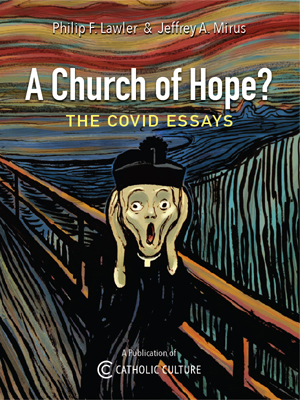the good, the bad, and the ugly
By Diogenes ( articles ) | Mar 05, 2005
Barbara Nicolosi speaks some painful truths about that painful session of fingernails-dragged-across-the-blackboard to which most of us subject ourselves weekly:
A commitment to beauty [in the Church] is meaningless without a requisite commitment to the things that beauty demands. ... The people who can produce beautiful art are rare. Artistic talent has nothing to do with the qualities of a person's heart, or the level of his devotion. For most pastors the most difficult aspect of leading the movement to restore beauty in the Church won't be writing checks, but it will be in confronting those very nice people who should never be allowed anywhere within one hundred miles of an open microphone.
Having recounted the infelicities visited on her parish by its ministers of music -- "two of the nicest Catholic folks you might ever meet, Tone deaf Charlie and Tempo-free Doris" -- Nicolosi continues
A group of us parishioners recruited a sponsor and a few music grad students from the local university to stop the insanity, and bring some beauty to our Sunday Mass. But when we brought the fully-funded proposal to our pastor, he killed it. "I would never want to offend Charlie and Doris. Maybe their voices aren't that good, but their hearts are pleasing to God." This was nothing but cowardice wearing a mask of charity. It isn't charity to spare the feelings of two people, while flaying the sensibilities and pastoral needs of hundreds of others.
Strike a chord, folks? Yet this is just the tip of the aesthetic iceberg. A parish can disencumber itself of a bad musician (or hymnal) with relative ease. It's more awkward to replace the work of an incompetent sculptor; harder still to undo the damage done by a church architect with an attitude.
Let's not forget the rarest and most stingily endowed of all aesthetic gifts, that of making beautiful prose translations from ancient languages. The 16th century Anglicans had it in freakish abundance, but there are no Coverdales or Cranmers in the intervening years. Here and there you'll find a melodious passage in the contemporary English renderings of the Bible or the Mass, but for the most part hearing them proclaimed is like eating dry spackle with a spoon, and the new Lectionary has clunkers that cause real pain -- vivid, biting-on-a-bad-tooth pain. Ironically, liturgical and biblical translations are not only the commonest aesthetic failures but also the hardest of all aesthetic failures to undo. A blessed hour might see a terrorist with a car bomb erase an architectural eyesore, but an ICEL sacramentary, alas, is a gift that keeps on giving.
All comments are moderated. To lighten our editing burden, only current donors are allowed to Sound Off. If you are a current donor, log in to see the comment form; otherwise please support our work, and Sound Off!







